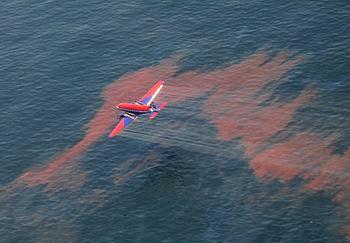
WASHINGTON, DC, August 7, 2012 (ENS) – A coalition of conservation, wildlife and public health groups in the Gulf of Mexico region and in Alaska filed a Clean Water Act lawsuit Monday to compel the U.S. EPA to issue a rule on oil dispersant chemicals.
The groups contend that the EPA’s current rules do not satisfy the requirements of the Clean Water Act.
They point to the the 2010 BP Deepwater Horizon oil spill in the Gulf of Mexico during which, they argue, dispersants applied to break up the millions of barrels of oil that gushed for three months from BP’s Macondo well were not used safely.

During the BP Deepwater Horizon incident, some 1.84 million gallons of dispersants were applied to Gulf waters “with little knowledge or research into the chemicals’ impacts,” the plaintiff groups argue.
Currently, regulations governing which dispersants are eligible for use in oil spills require minimal toxicity testing and no threshold for safety, they point out.
“We’re disappointed that the agency doesn’t seem to understand the widespread public urgency to initiate this rulemaking process,” said Jill Mastrototaro, director of the Sierra Club Gulf Coast Protection Campaign. “If a spill or blowout happened tomorrow in the Gulf of Mexico, or any U.S. water for that matter, any dispersant that is used would not necessarily be safe for the waters, ecosystems, response workers, or nearby communities.”
The plaintiff groups point to a study published this week by the Dauphin Island Sea Lab and scientists from two Alabama universities, showing that the dispersants applied during the BP oil spill may have disrupted the food chain in the Gulf of Mexico, where commercial fishing provides food for the nation.
“… dispersants cause marked changes in natural microbial communities in the Gulf, which disrupts the flow of energy at the base of the food chain,” the scientists wrote.
They found that dispersants cause the disappearance of phytoplankton, microscopic plants that are the engines of marine food chains. Through photosynthesis these tiny plants provide energy for slightly larger animals called zooplankton, and for the small fish that feed on zooplankton.
Public interest environmental law firm Earthjustice filed the lawsuit on behalf of the Louisiana Shrimp Association, Florida Wildlife Federation, Gulf Restoration Network, Louisiana Environmental Action Network, Alaska-based Cook Inletkeeper, Alaska Community Action on Toxics, Waterkeeper Alliance, and Sierra Club.
“We sent EPA a notice of intent to sue in October 2010 following the debacle of the BP Deepwater Horizon disaster and the unprecedented use of dispersants during that response,” said Earthjustice attorney Hannah Chang, who is representing the groups in court. “Our filing today will push EPA to take further action to follow through on its promise to get a much-needed rule in place.”
“The Clean Water Act requirements have been in place for decades, but administration after administration has failed to comply with the law,” said Cyn Sarthou, executive director of Gulf Restoration Network. “Consequently, there was little data available to EPA officials when they were confronted with the devastating BP oil disaster.”
Over 5,000 petitions have been sent by residents across the Gulf Coast region urging EPA to use its authority to initiate comprehensive testing of oil dispersants and to create regulations that include safety criteria and identify acceptable waters and quantities for use. But EPA has not created a new rule.
Bob Shavelson with Alaska-based Cook Inletkeeper said, “The oil industry learned from the Exxon Valdez that ‘out of sight, out of mind’ is its preferred spill response strategy, so the first tool out of the box these days is dispersants. But dispersants add toxic insult to injury for Alaskan fisheries and Alaskans have a right to know about toxic pollution around our coastal communities.”
“The damage in the Gulf has already been done. Nearly two million gallons of dispersants with essentially unknown environmental effects were released into the waters,” said Marc Yaggi, executive director of Waterkeeper Alliance. “We need more effective and responsible EPA dispersant rules so that we are never caught unprepared and uninformed in a crisis situation again.”
Copyright Environment News Service (ENS) 2012. All rights reserved.
© 2012, Environment News Service. All rights reserved. Content may be quoted only with proper attribution and a direct link to the original article. Full reproduction is prohibited.
